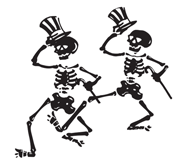Grateful Dead Hour no. 17
Week of December 26, 1988
Featuring excerpts from the Grateful Dead's second set July 26, 1987 at the Big A (Anaheim Stadium), not far from Disneyland and Leo Fender's house.
Peter Apfelbaum and Hieroglyphics Ensemble was Phil Lesh's choice to open the show on New Year's Eve. It's a 15-piece band from Berkeley, using some "World Beat" dance rhythms for composition and improvisation in a big-band context. I think this band should appeal equally to the dancers and the serious listeners in the Grateful Dead audience.
The following is an excerpt from an interview with Apfelbaum on the December 1988 installment of Rex Radio, hosted by Phil Lesh.
Lesh: [Recalling a newspaper article in which] you were extolling the virtues of Reggae and African rhythms as opposed to swing rhythms... You were saying that most jazz composers only rely on swing rhythms, and that Reggae and African are a whole new untapped resource, in a way. And to my ears you've taken those rhythms and developed them considerably - especially overlaying more than one at one time.
Apfelbaum: That is a product of our continuing investigation of the roots of what we call jazz. In the process of investigating that root we realized that the basis of swing and the basis of the rhythms that make up what we call jazz come from Africa - specifically, from West Africa. There've been numerous attempts in this century to combine African rhythms with American jazz. Dizzy Gillespie was somebody who did that by way of Afro-Cuban music; Ellington did it, and more recently the Art Ensemble of Chicago, Sun Ra... There was an outgrowth of awareness in the sixties that contributed to the overall awareness of African music, and it became an element that is more and more used in composition. What we're doing is taking modern dance forms and using them as a basis for composition and improvisation, much in the way that Ellington did, and people of his time that were orchestrating for a large ensemble.
Enjoy!!
"Gift" montage
Grateful Dead 7/26/87 Anaheim Stadium
SHAKEDOWN STREET
Peter Apfelbaum and the Hieroglyphics Ensemble with Don Cherry, 10/14/88 Palace of Fine Arts Theatre, San Francisco
NOTES FROM THE ROSETTA STONE (FIRST SECTION)
Grateful Dead from the Mars Hotel
CHINA DOLL
Grateful Dead 7/26/87 Anaheim Stadium
TERRAPIN STATION->
DRUMS
THROWING STONES
Rolling Stones, The Rolling Stones
NOT FADE AWAY
Every Wednesday, we post a program from the Grateful Dead Hour archives for your enjoyment and enlightenment. You can browse or search the playlists at gdhour.com or on the GD Hour Search page, and let me know what program(s) you'd like to hear by emailing me at gdhour@dead.net.
Thank you for listening!
- David Gans
Producer/host




